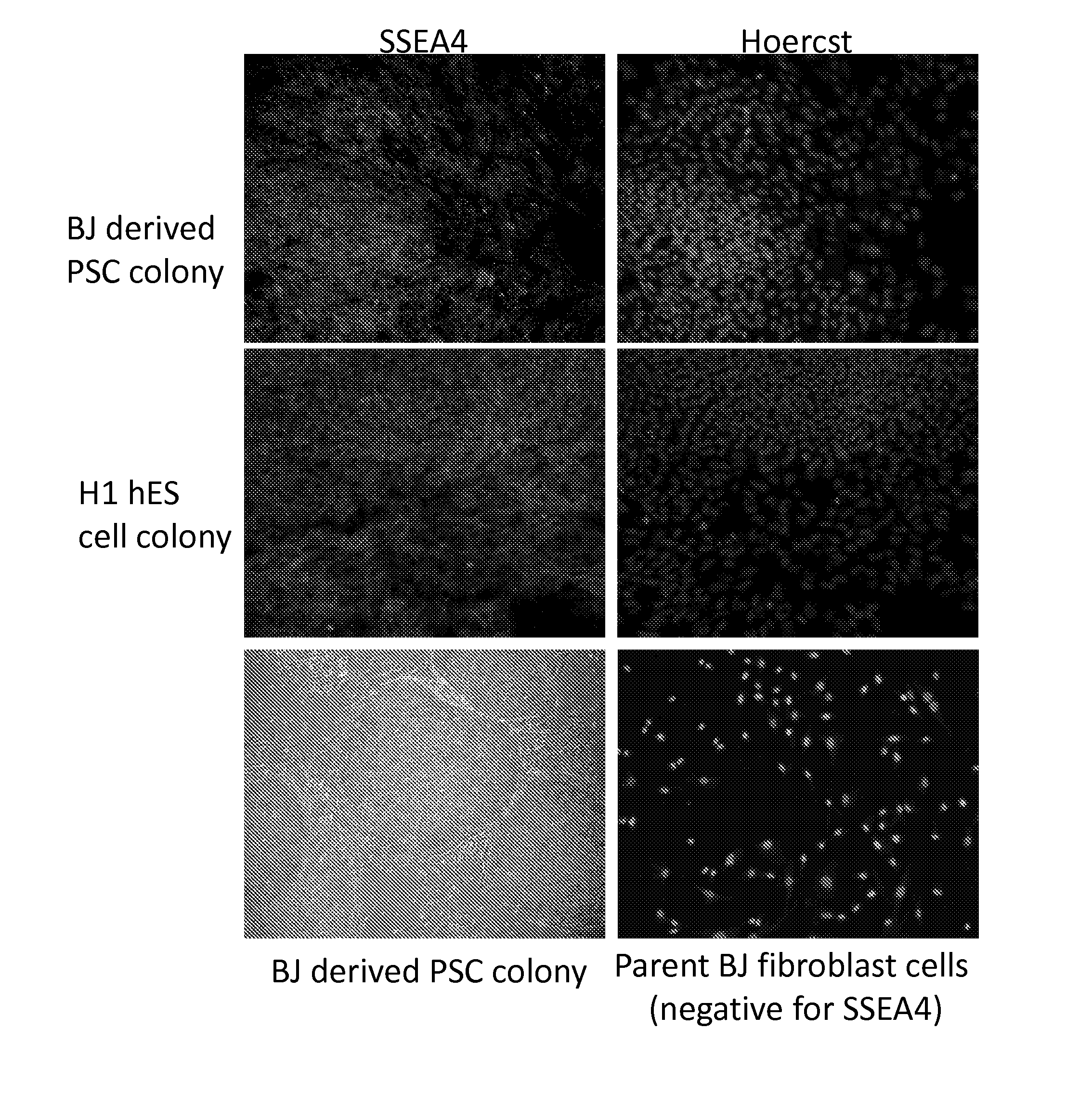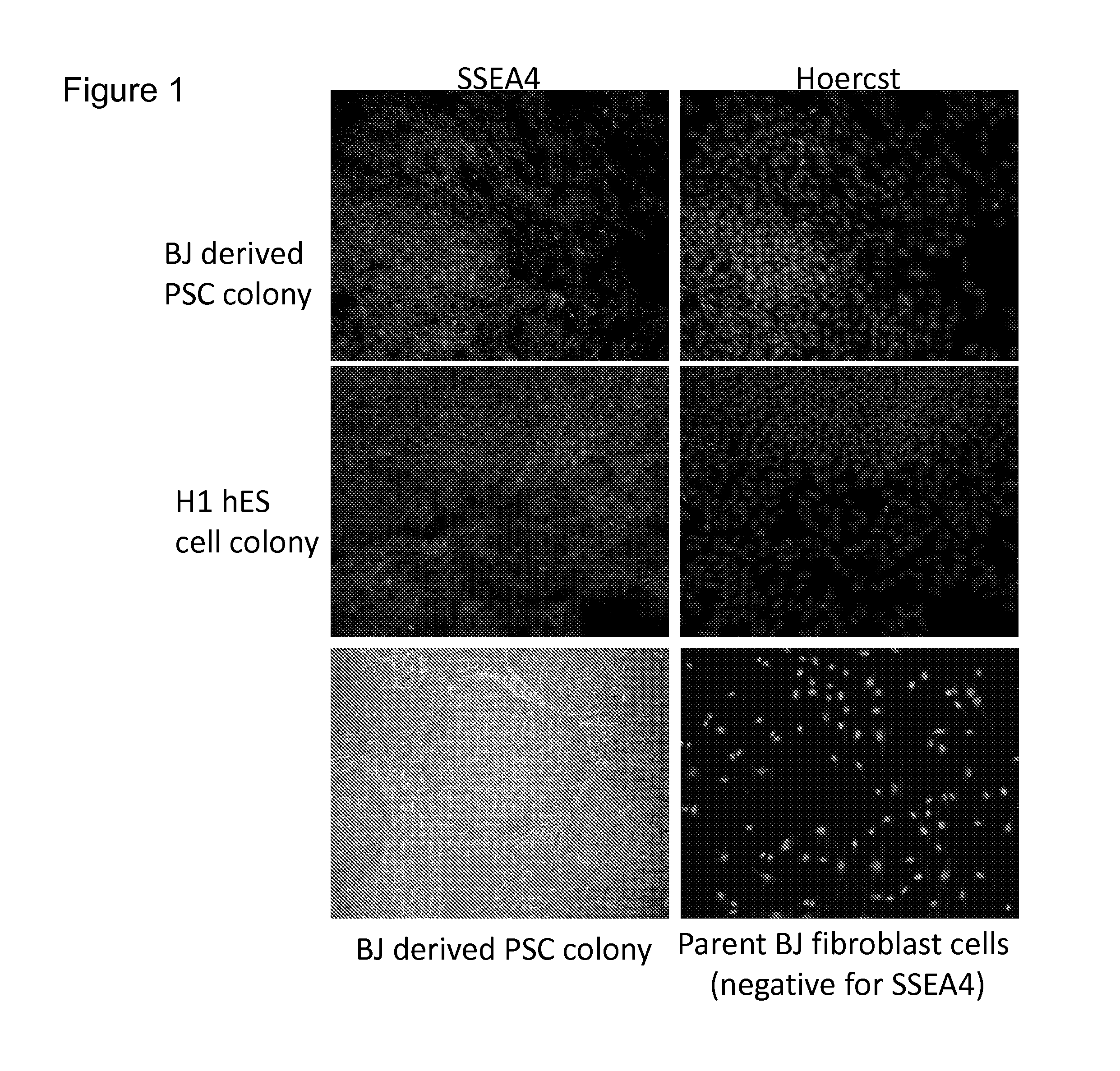Pluripotent Stem Cells
a stem cell and pluripotent technology, applied in the field of pluripotent stem cells, can solve the problems of failure to produce adult chimaeras, lack of promise, and different gene expression and dna methylation patterns, and achieve the effect of increasing viral transfection efficiency
- Summary
- Abstract
- Description
- Claims
- Application Information
AI Technical Summary
Benefits of technology
Problems solved by technology
Method used
Image
Examples
example 1
Generation of Pluripotent Stem Cells from Somatic Cells with Feeder Cells Using the STEMGENT™ Human Transfection Factor Kit
Using the method stated in the Stemgent™ human transfection factor kit, pluripotent stem cells were generated from adult foreskin fibroblast cells, using the Stemgent™ Human TF Lentivirus Set (Cat. No. 00-0005). CRL2522 cells from ATCC (human foreskin fibroblasts referred to as “BJ” cells in the Stemgent protocol) were plated to a 6 well plate in growth media at a density of 100,000 cells / well which resulted in a confluency of 40-50%. The growth media consisted of 450 ml EMEM, 50 ml ES-qualified FBS, 5 ml 10 mM Non-Essential Amino Acids, 5 ml penicillin (10,000 U / ml)-streptomycin (10,000 μg / ml), 5 ml 200 mM L-glutamine, and 0.9 ml 55 mM β-mercaptoethanol (referred to herein as BJ cell growth media). The day after plating the cells, media was changed to fresh BJ cell growth media plus polybrene and lentiviruses in a total volume of 2.5 ml (Conditions #1 and 2, Ta...
example 2
Generation of Pluripotent Stem Cells from Somatic Cells Using the STEMGENT™ Human Transfection Factor Kit without the Use of Feeder Cells
100,000 amniotic fluid-derived cells isolated according to the methods disclosed in U.S. patent application Ser. No. 11 / 420,895 were plated in AMNIOMAX™ media in a 10 cm2 well of a six well dish. The following day cells were transduced with lentivirus virus according to Condition #7 in Table 1. Media was changed to fresh AMNIOMAX™ media plus lentiviruses in a total volume of 2.5 ml. Lentivirus viral titer was determined by the manufacturer using p24 capsid antigen ELISA assay. Viral titers were as follows: SOX2-Lentivirus titer—68.80 ng / ml; OCT4-Lentivirus titer—6.64 ng / ml; LIN28-Lentivirus titer—68.80 ng / ml; and NANOG-Lentivirus titer—82.80 ng / ml.
The viral transduction used in this example did not use the transduction enhancement agent, polybrene (The following day cells were transduced with lentivirus virus according to Condition #7, Table 1). On...
example 3
Generation of Pluripotent Stem Cells from Somatic Cells Using the STEMGENT™ Human Transfection Factor Kit without the Use of Feeder Cells
We were not able to derive pluripotent cells using a feeder layer of MEF cells without the use of polybrene on feeder cells (see Conditions #3-6, Table 1). CRL22429 cells (foreskin fibroblast cells, ATCC, Manassas Va. USA) or AF cells were plated at a concentration of 100,000 cells into separate 10 cm2 wells of a six well dish overnight. The next day cells were treated with fresh media containing the recommended amount of virus for 24 hours without polybrene. On the third day cells were TrypLE treated and passaged onto MEF cells in hESC / iPS cell media with 5 μM of the ROCK inhibitor Y27632 to promote adhesion. Parallel populations of cells were also treated with three compounds that have been reported to improve pluripotent stem cell colony formation: CHIR99021 at 100 nM, BIX01294 at 1 μM, and R (T)Bay K 8644 at 2 μM. Media was changed each day for...
PUM
| Property | Measurement | Unit |
|---|---|---|
| total volume | aaaaa | aaaaa |
| colony morphology | aaaaa | aaaaa |
| morphology | aaaaa | aaaaa |
Abstract
Description
Claims
Application Information
 Login to View More
Login to View More - R&D
- Intellectual Property
- Life Sciences
- Materials
- Tech Scout
- Unparalleled Data Quality
- Higher Quality Content
- 60% Fewer Hallucinations
Browse by: Latest US Patents, China's latest patents, Technical Efficacy Thesaurus, Application Domain, Technology Topic, Popular Technical Reports.
© 2025 PatSnap. All rights reserved.Legal|Privacy policy|Modern Slavery Act Transparency Statement|Sitemap|About US| Contact US: help@patsnap.com



